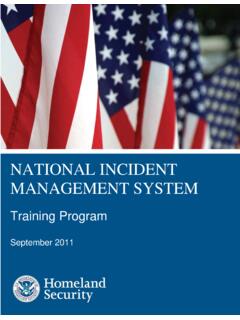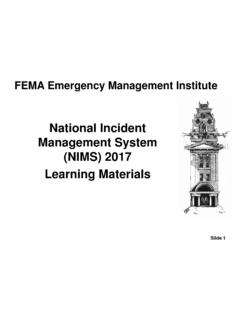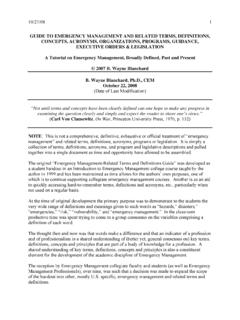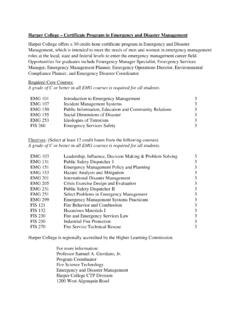Transcription of IS-0200.c Basic Incident Command System for Initial ...
1 Basic Incident Command System for Initial Response, ICS 200 Student Manual Date Released: 09/2020 September 2020 Basic Incident Command System for Initial Response, ICS 200 lesson 1: Course overview SM-1 Contents lesson 1: Course overview .. 2 lesson 2: Incident Command and Unified Command .. 31 lesson 3: Delegation of Authority & Management by Objectives .. 73 lesson 4: Functional Areas and Positions .. 108 lesson 5: Incident Briefings and Meetings .. 154 lesson 6: Organizational Flexibility .. 174 lesson 7: Transfer of 216 lesson 8: Application Activity .. 230 lesson 9: Course Summary .. 274 September 2020 Basic Incident Command System for Initial Response, ICS 200 lesson 1: Course overview SM-2 lesson 1: Course overview September 2020 Basic Incident Command System for Initial Response, ICS 200 lesson 1: Course overview SM-3 Visual 1: Course Welcome The Emergency Management Institute developed the Basic Incident Command System for Initial Response, ICS 200 course in collaboration with: National Wildfire Coordinating Group (NWCG) Department of Agriculture (USDA) Fire Administration's National Fire Programs Branch United States Coast Guard (USCG) follows NIMS guidelines and meets the National Incident Management System (NIMS) Baseline Training requirements for ICS 200.
2 Note This course is a part of the series of ICS courses designed to meet the all-hazards, all-agency NIMS ICS requirement for operational personnel. Descriptions and details about the other ICS courses in the series may be found on our Web site: September 2020 Basic Incident Command System for Initial Response, ICS 200 lesson 1: Course overview SM-4 Visual 2: Course Objectives This course is designed to enable personnel to operate efficiently during an Incident or event within the Incident Command System (ICS) and focuses on the management of an Initial response to an Incident . Overall Course Objectives At the end of the course, you should be able to: Describe the course objectives and summarize Basic information about the Incident Command System (ICS) and National Incident Management System (NIMS).
3 Describe how the NIMS Management Characteristics relate to Incident Command and Unified Command . Describe the delegation of authority process, implementing authorities, management by objectives, and preparedness plans and objectives. Identify ICS organizational components, the Command Staff, the General Staff, and ICS tools. Describe different types of briefings and meetings. Explain flexibility within the standard ICS organizational structure. Explain transfer of Command briefings and procedures. Use ICS to manage an Incident or event. September 2020 Basic Incident Command System for Initial Response, ICS 200 lesson 1: Course overview SM-5 Visual 3: Student Introductions Introduce yourself by providing: Your name Your job title A brief statement of your overall experience with emergency or Incident response Your possible roles in responding to incidents September 2020 Basic Incident Command System for Initial Response, ICS 200 lesson 1: Course overview SM-6 Visual 4: Student Expectations What do you expect to gain from this course?
4 September 2020 Basic Incident Command System for Initial Response, ICS 200 lesson 1: Course overview SM-7 Visual 5: Instructor Expectations Cooperate with the group. Be open minded to new ideas. Participate actively in all of the training activities. Return to class at the stated time. Use what you learn in the course to perform effectively within an ICS organization. September 2020 Basic Incident Command System for Initial Response, ICS 200 lesson 1: Course overview SM-8 Visual 6: Course Structure This course is divided into eight units plus the Course Summary. Unit 1: Course overview Unit 2: Incident Command and Unified Command Unit 3: Delegation of Authority and Management by Objectives Unit 4: Functional Areas and Positions Unit 5: Incident Briefings and Meetings Unit 6: Organizational Flexibility Unit 7: Transfer of Command Unit 8: Application Activity Unit 9: Course Summary September 2020 Basic Incident Command System for Initial Response, ICS 200 lesson 1: Course overview SM-9 Visual 7: Course Logistics Review the following information: Course agenda Sign-in sheet Breaks Message and telephone location Cell phone policy Facilities Other concerns September 2020 Basic Incident Command System for Initial Response, ICS 200 lesson 1.
5 Course overview SM-10 Visual 8: Agenda DAY 1 DAY 2 Morning Session Morning Session Unit 1: Course overview Unit 2: Incident Command and Unified Command Unit 6: Organizational Flexibility Afternoon Session Afternoon Session Unit 3: Delegation of Authority & Management by Objectives Unit 4: Functional Areas & Positions Unit 7: Transfer of Command Unit 8: Application Activity Unit 9: Course Summary and Final Exam September 2020 Basic Incident Command System for Initial Response, ICS 200 lesson 1: Course overview SM-11 Visual 9: Course Completion In order to successfully complete this course, you must: Participate in unit activities. Achieve 75% or higher on the final exam. Complete the end-of-course evaluation. September 2020 Basic Incident Command System for Initial Response, ICS 200 lesson 1: Course overview SM-12 Unit Objectives This unit provides an overview of the Incident Command System (ICS) and the National Incident Management System (NIMS).
6 At the end of this unit, you should be able to: Describe the Incident Command System (ICS). Describe the National Incident Management System (NIMS). September 2020 Basic Incident Command System for Initial Response, ICS 200 lesson 1: Course overview SM-13 Visual 10: lesson 1 overview This lesson provides an overview of the Incident Command System (ICS) and the National Incident Management System (NIMS). lesson Objectives At the end of this lesson , you should be able to: Describe the Incident Command System (ICS). Describe the National Incident Management System (NIMS). September 2020 Basic Incident Command System for Initial Response, ICS 200 lesson 1: Course overview SM-14 Visual 11: Incident Command System (ICS) ICS: Is a standardized management tool for meeting the demands of small or large emergency or nonemergency situations Represents "best practices," and has become the standard for emergency management across the country May be used for planned events, natural disasters, and acts of terrorism Is a part of the National Incident Management System (NIMS) ICS is not just a standardized organizational chart, but an entire management System .
7 September 2020 Basic Incident Command System for Initial Response, ICS 200 lesson 1: Course overview SM-15 Visual 12: Why ICS? All levels of government, the private sector, and nongovernmental agencies must be prepared to prevent, protect against, mitigate, respond to, and recover from a wide spectrum of major events and natural disasters that exceed the capabilities of any single entity. Threats from natural disasters and human-caused events, such as terrorism, require a unified and coordinated national approach to planning and to domestic Incident management. September 2020 Basic Incident Command System for Initial Response, ICS 200 lesson 1: Course overview SM-16 Visual 13: Homeland Security Presidential Directives HSPD-5, Management of Domestic Incidents, identified steps for improved coordination in response to incidents.
8 It required the Department of Homeland Security (DHS) to coordinate with other Federal departments and agencies and State, local, and tribal governments to establish a National Response Framework (NRF) and a National Incident Management System (NIMS). HSPD-8, National Preparedness, directed DHS to lead a national initiative to develop a National Preparedness System a common, unified approach to strengthen the preparedness of the United States to prevent and respond to threatened or actual domestic terrorist attacks, major disasters, and other emergencies. Presidential Policy Directive 8 (PPD-8), National Preparedness, describes the Nation's approach to preparedness-one that involves the whole community, including individuals, businesses, community- and faith-based organizations, schools, tribes, and all levels of government (Federal, State, local, tribal and territorial).
9 Note HSPD-5, HSPD-8, and PPD-8 Copies of the HSPD-5, Management of Domestic Incidents, HSPD-8, National Preparedness, and Presidential Policy Directive 8 (PPD-8), National Preparedness can be found online. Please use the links below to access them. HSPD-5, Management of Domestic Incidents: HSPD-8, National Preparedness: Presidential Policy Directive 8 (PPD-8), National Preparedness: national-preparedness September 2020 Basic Incident Command System for Initial Response, ICS 200 lesson 1: Course overview SM-17 Visual 14: National Incident Management System (NIMS) overview NIMS provides a consistent framework for Incident management at all jurisdictional levels regardless of the cause, size, or complexity of the Incident . NIMS provides the Nation's first responders and authorities with the same foundation for Incident management for terrorist attacks, natural disasters, and other emergencies.
10 Note Implementing NIMS According to the National Integration Center, "Implementing the use of NIMS" means that government officials, Incident managers, and emergency response organizations at all jurisdictional levels adopt the National Incident Management System . Actions to implement the use of NIMS take place at two levels - policy and organizational/operational. At the policy level, implementing NIMS means government officials, , governors, mayors, county and city managers, tribal leaders, and others: Adopt the NIMS through executive order, proclamation, or legislation as the jurisdiction's official Incident response System ; and Direct that Incident managers and response organizations in their jurisdictions train, exercise, and use the NIMS in their response operations.










